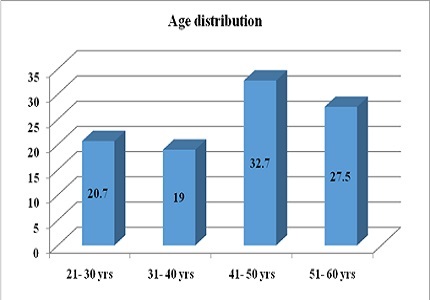Study of central line-associated bloodstream infections in intensive care unit: a prospective observational study
Abstract
Introduction: Central line associated blood stream infection (CLABSI) is a primary blood stream infection in a patient that had a central line within the 48-hour period before the development of bacteraemia and is not related to an infection at another site. It is often associated with serious infectious complications resulting in significant morbidity, increased duration of hospitalization and additional medical costs.
Objective: We aimed to study the course of infection, microbiology of CLABSI, & to identify the degrees of severity of sepsis associated with CLABSI.
Materials & Methods: Patients admitted in Intensive care units who fulfilled the inclusion criteria were enrolled. Various demographic, microbial and patients characteristics were noted along with outcome using a prestructured proforma.
Results: We studied 58 patients in ICU in which males were common, Sepsis seen in 43% of patients, 37% had Staph. Aureus, and the mortality was 24.1%.
Conclusion: CLABSI infection is best prevented rather than cured. It has mortality as high as 24.13%. It can manifest with varying degrees of severity of sepsis. Organ Dysfunction, multi organ involvement, TLC abnormalities, Oliguria, altered mental status, Hypotension are all markers of poor prognosis. More scientific data on the subject is required to formulate guidelines and protocols for prevention and treatment of CLABSI.
Downloads
References
Longo DL, Fauci AS, Kasper DL, Hauser SL, Jameson JL, Loscalzo J: Harrisons principles of internal medicine.18 ed. New York. The McGraw-Hill Companies, Inc. 2011, p1116.
O'Grady NP, Alexander M, Burns LA, Dellinger EP, Garland J, Heard SO, Lipsett PA, Masur H, Mermel LA, Pearson ML, Raad II, Randolph AG, Rupp ME, Saint S; Healthcare Infection Control Practices Advisory Committee (HICPAC). Guidelines for the prevention of intravascular catheter-related infections. Clin Infect Dis. 2011 May;52(9):e162-93. doi: https://doi.org/10.1093/cid/cir257. Epub 2011 Apr 1.
Longo DL, Fauci AS, Kasper DL, Hauser SL, Jameson JL, Loscalzo J. Harrisons principles of internal medicine. 18 ed. New York. The McGraw-Hill Companies, Inc.2011 p1117.
Naomi P. O'Grady, Didier P. Catheter-Related Infections in the Critically Ill. Norvell. Kluwer Academic Publishers, 2004, p90.
Foster C, Mistry N, Peddi P, Sharma S.The Washington Manual of Medical Therapeutics. 33rd ed. New Delhi:WoltersKluver(India) Pvt Ltd.2010, p503.
Jordi R, Martin H, Emilio D, Alejandro R. Infectious Diseases in Critical Care, Berlin,Springer Science & Business Media, 2010, p7.
Rijnders B, Intravascular Catheter-Related Infections: A Clinical Focus on Prevention, Diagnosis & Treatment.Belgium, Leuven University Press, 2003, p 21.
Dimick JB, Pelz RK, Consunji R, Swoboda SM, Hendrix CW, Lipsett PA. Increased resource use associated with catheter-related bloodstream infection in the surgical intensive care unit. Arch Surg. 2001 Feb;136(2):229-34.
World Health Organization (WHO) Preventing bloodstream infections from central line venous catheters [Internet].(cited 28august 2014)Available from: http://www.who.int/patientsafety/implementation/BSI/en/
Esherick J, The Tarascon Clinical Review Series: Internal Medicine, Chapter 48- Management of Catheter Related Blood stream infections, Jones & Bartlett Publishers, 2012p217.
Mer M. Intravascular catheter-related infection-current concepts. Southern African Journal of Critical Care. 2006;22(1):4-12.
Mermel LA, Farr BM, Sherertz RJ, Raad II, O'Grady N, Harris JS, Craven DE; Infectious Diseases Society of America, American College of Critical Care Medicine, Society for Healthcare Epidemiology of America. Guidelines for the management of intravascular catheter-related infections. J Intraven Nurs. 2001 May-Jun;24(3):180-205.
Patil HV, Patil VC, Ramteerthkar MN, Kulkarni RD. Central venous catheter-related bloodstream infections in the intensive care unit. Indian J Crit Care Med. 2011 Oct;15(4):213-23. doi: https://doi.org/10.4103/0972-5229.92074.
Deepti, Sinha S, Sharma SK, Aggarwal P, Biswas A, Sood S, Ragunandan P, Ekka M, Xess I, Sreenivas V. Central venous catheter related bloodstream infections in medical intensive care unit patients in a tertiary referral centre. Indian J Chest Dis Allied Sci. 2014 Apr-Jun;56(2):85-91.
Patil HV, Patil VC, Ramteerthkar MN, Kulkarni RD. Central venous catheter-related bloodstream infections in the intensive care unit. Indian J Crit Care Med. 2011 Oct;15(4):213-23. doi: 10.4103/0972-5229.92074.
O'Connor A, Hanly AM, Francis E, Keane N, McNamara DA. Catheter associated blood stream infections in patients receiving parenteral nutrition: a prospective study of 850 patients. Journal of clinical medicine research. 2013 Jan 11;5(1):18-21.
Parameswaran R, Sherchan JB, Varma M, Mukhopadhyay C, Vidyasagar S. Intravascular catheter-related infections in an Indian tertiary care hospital. The Journal of Infection in Developing Countries. 2010 Nov 11;5(06):452-8.
Chopdekar K, Chande C, Chavan S, Veer P, Wabale V, Vishwakarma K, Joshi A. Central venous catheter-related blood stream infection rate in critical care units in a tertiary care, teaching hospital in Mumbai. Indian J Med Microbiol. 2011 Apr-Jun;29(2):169-71. doi: https://doi.org/10.4103/0255-0857.81796.



 OAI - Open Archives Initiative
OAI - Open Archives Initiative


